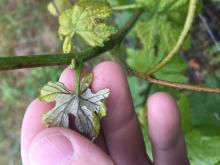Cause An occasional physiological disorder of wine grapes marked by characteristic foliar symptoms early in the season. It may be associated with a disruption of healthy nitrogen metabolism in developing shoots. Symptoms occur in rapidly expanding tissues such as shoot tips and unfolding leaves and may vary in intensity with the timing and length of early-season low temperatures. Symptoms seem to be exacerbated by earlier and persistent periods of low temperatures, though symptom expression may vary widely across clones, cultivars, vineyards, and growth stages. The disorder was been reported in southern Oregon in springs of 2019, 2020 and 2021. Pinot leaf curl has also been reported sporadically in the south Willamette Valley and the Umpqua grape growing region. This disorder has not been reported in Washington or Idaho vineyards. Due to its association with extended periods of low temperatures from early shoot elongation through bloom, PLC symptoms may be prevalent across the state. The disorder is most severe in the Pinot-family cultivars, such as Pinot noir, Pinot blanc, Pinot gris, and Pinot meunier, though symptoms have been documented in Syrah, Chardonnay, and Cabernet Sauvignon as well.
Symptoms Curling of leaf blades is considered a mild symptom with a necrotic region in the central vein near the petiole and leaf blade juncture on the underside of the leaf. Beyond this necrotic area the leaf blade will curl back towards the shoot. More severe symptoms include stunted shoots, partial shoot dieback, petiole necrosis, leaf necrosis, leaf abscission, cluster loss, and orphaned clusters where the shoot tip abscises just above an unaffected cluster. In some cases there can be nodes with only a cluster, with no shoot present. Often individual shoots are affected within vines and not the entire vine. Symptoms may also be found on growing shoot tips much later in the season, although this is primarily an early season disorder.
This disorder may be mistaken for Botrytis shoot blight, but that is promoted by warm moist weather, whereas this disorder is associated with early-season cool temperatures. It is also not related to Grapevine leafroll disease that may cause rolling of leaf margins later in the season.
Control There is no recommendation for managing this disorder. Pesticides are not recommended.
Reference Adams D. O., Franke K. E., and Christensen L. P. 1990. Elevated Putrescine Levels in Grapevine Leaves That Display Symptoms of Potassium Deficiency. Am J Enol Vitic 41:121-125.



